BTM 5919: International Trade Law vs. Life Below Water Protection
VerifiedAdded on 2023/06/07
|13
|3704
|187
Report
AI Summary
This report investigates the extent to which international trade law is inconsistent with measures designed to protect "Life Below Water," focusing on Sustainable Development Goal 14 (SDG 14). It begins by outlining the importance of SDG 14 and the measures it promotes for ocean conservation. The report then examines international trade law, specifically the General Agreement on Tariffs and Trade (GATT) and the World Trade Organization (WTO), highlighting how their principles and regulations can conflict with environmental protection efforts. Through analysis of relevant cases, such as the Canada v. US fish trade export ban, the report illustrates specific inconsistencies, such as the clash between trade liberalization and environmental regulations. The report also examines the evolution from GATT to the WTO and its implications. Overall, the report concludes by assessing the challenges in balancing international trade and marine environmental protection.
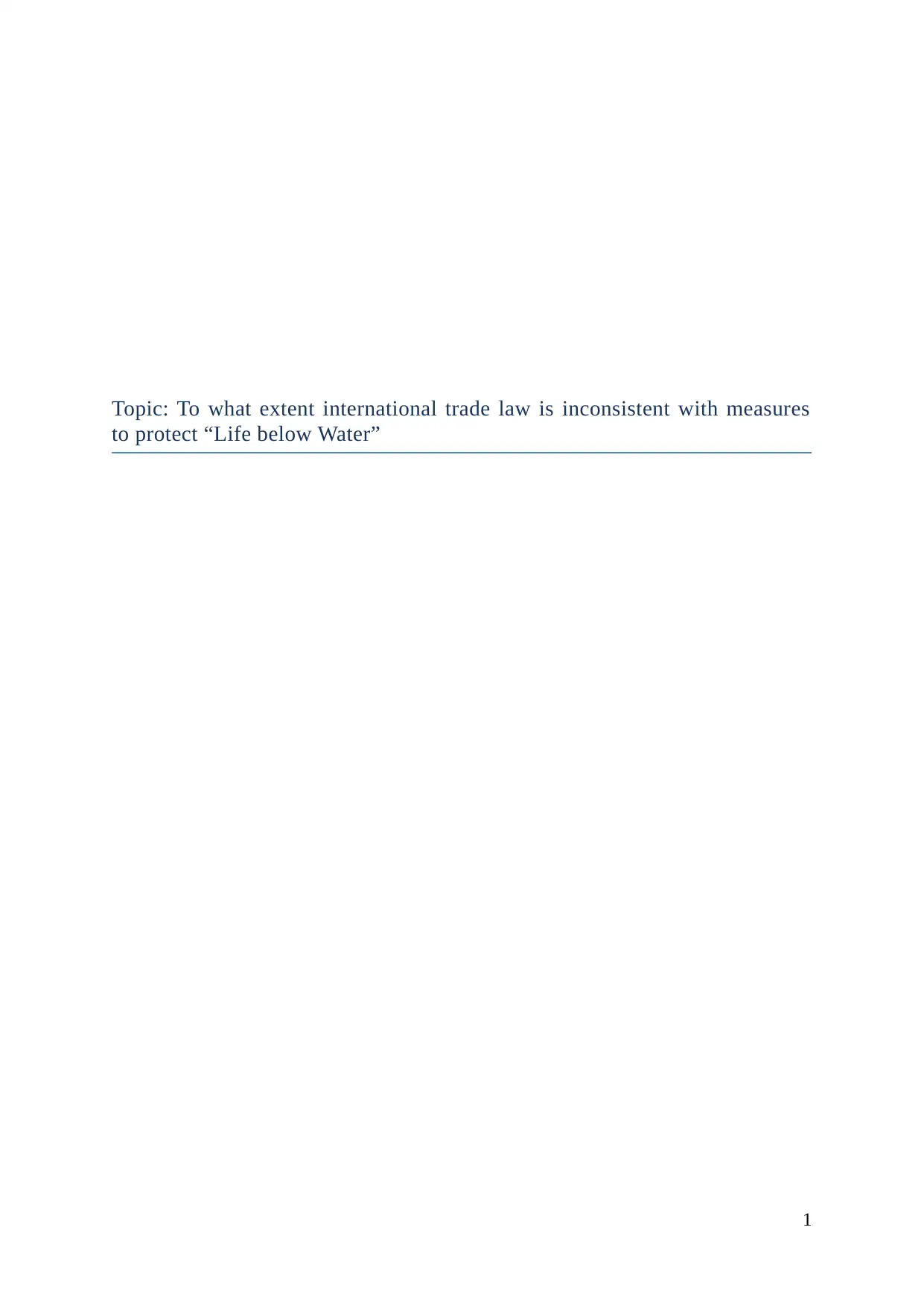
Topic: To what extent international trade law is inconsistent with measures
to protect “Life below Water”
1
to protect “Life below Water”
1
Paraphrase This Document
Need a fresh take? Get an instant paraphrase of this document with our AI Paraphraser
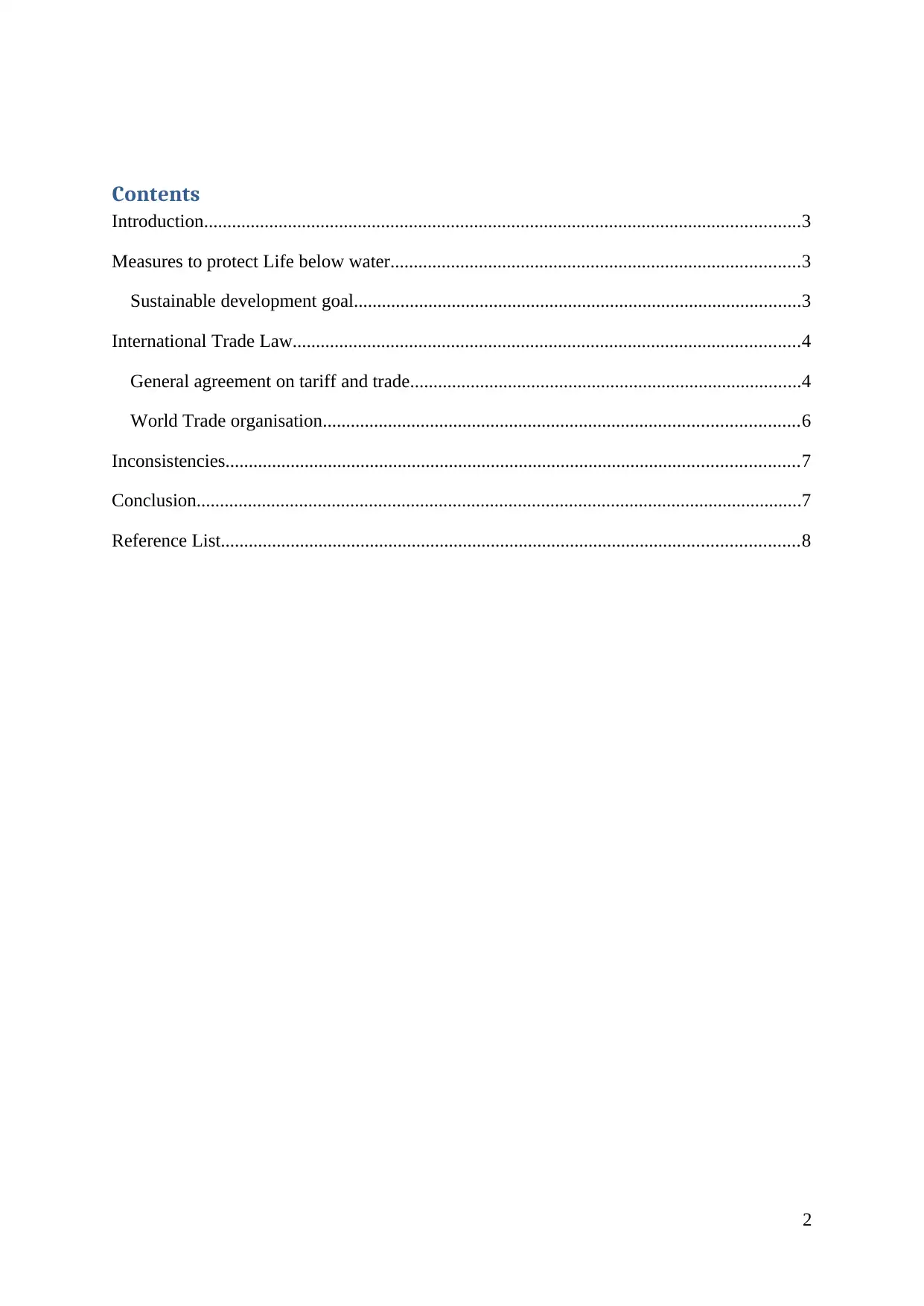
Contents
Introduction................................................................................................................................3
Measures to protect Life below water........................................................................................3
Sustainable development goal................................................................................................3
International Trade Law.............................................................................................................4
General agreement on tariff and trade....................................................................................4
World Trade organisation......................................................................................................6
Inconsistencies...........................................................................................................................7
Conclusion..................................................................................................................................7
Reference List............................................................................................................................8
2
Introduction................................................................................................................................3
Measures to protect Life below water........................................................................................3
Sustainable development goal................................................................................................3
International Trade Law.............................................................................................................4
General agreement on tariff and trade....................................................................................4
World Trade organisation......................................................................................................6
Inconsistencies...........................................................................................................................7
Conclusion..................................................................................................................................7
Reference List............................................................................................................................8
2
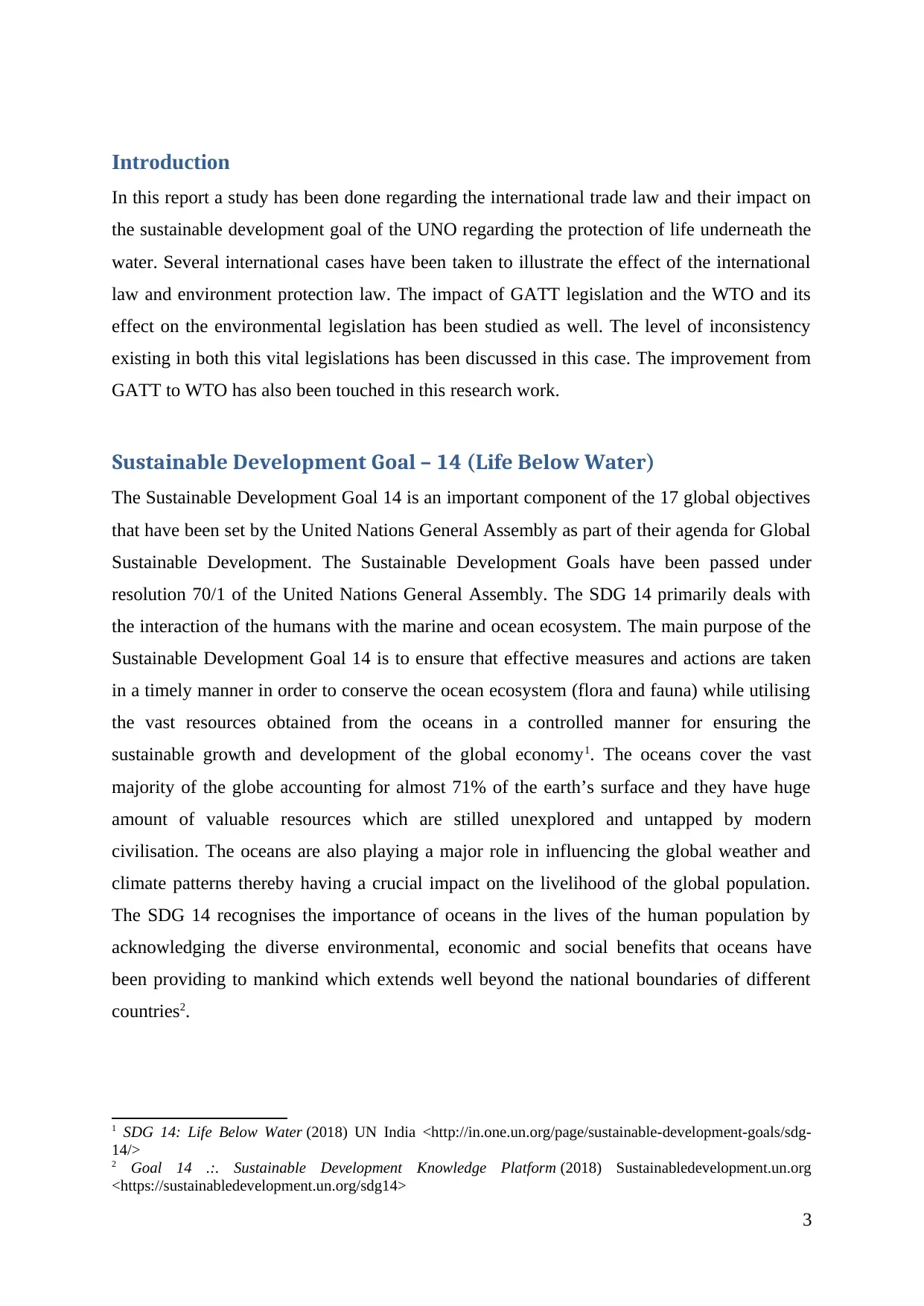
Introduction
In this report a study has been done regarding the international trade law and their impact on
the sustainable development goal of the UNO regarding the protection of life underneath the
water. Several international cases have been taken to illustrate the effect of the international
law and environment protection law. The impact of GATT legislation and the WTO and its
effect on the environmental legislation has been studied as well. The level of inconsistency
existing in both this vital legislations has been discussed in this case. The improvement from
GATT to WTO has also been touched in this research work.
Sustainable Development Goal – 14 (Life Below Water)
The Sustainable Development Goal 14 is an important component of the 17 global objectives
that have been set by the United Nations General Assembly as part of their agenda for Global
Sustainable Development. The Sustainable Development Goals have been passed under
resolution 70/1 of the United Nations General Assembly. The SDG 14 primarily deals with
the interaction of the humans with the marine and ocean ecosystem. The main purpose of the
Sustainable Development Goal 14 is to ensure that effective measures and actions are taken
in a timely manner in order to conserve the ocean ecosystem (flora and fauna) while utilising
the vast resources obtained from the oceans in a controlled manner for ensuring the
sustainable growth and development of the global economy1. The oceans cover the vast
majority of the globe accounting for almost 71% of the earth’s surface and they have huge
amount of valuable resources which are stilled unexplored and untapped by modern
civilisation. The oceans are also playing a major role in influencing the global weather and
climate patterns thereby having a crucial impact on the livelihood of the global population.
The SDG 14 recognises the importance of oceans in the lives of the human population by
acknowledging the diverse environmental, economic and social benefits that oceans have
been providing to mankind which extends well beyond the national boundaries of different
countries2.
1 SDG 14: Life Below Water (2018) UN India <http://in.one.un.org/page/sustainable-development-goals/sdg-
14/>
2 Goal 14 .:. Sustainable Development Knowledge Platform (2018) Sustainabledevelopment.un.org
<https://sustainabledevelopment.un.org/sdg14>
3
In this report a study has been done regarding the international trade law and their impact on
the sustainable development goal of the UNO regarding the protection of life underneath the
water. Several international cases have been taken to illustrate the effect of the international
law and environment protection law. The impact of GATT legislation and the WTO and its
effect on the environmental legislation has been studied as well. The level of inconsistency
existing in both this vital legislations has been discussed in this case. The improvement from
GATT to WTO has also been touched in this research work.
Sustainable Development Goal – 14 (Life Below Water)
The Sustainable Development Goal 14 is an important component of the 17 global objectives
that have been set by the United Nations General Assembly as part of their agenda for Global
Sustainable Development. The Sustainable Development Goals have been passed under
resolution 70/1 of the United Nations General Assembly. The SDG 14 primarily deals with
the interaction of the humans with the marine and ocean ecosystem. The main purpose of the
Sustainable Development Goal 14 is to ensure that effective measures and actions are taken
in a timely manner in order to conserve the ocean ecosystem (flora and fauna) while utilising
the vast resources obtained from the oceans in a controlled manner for ensuring the
sustainable growth and development of the global economy1. The oceans cover the vast
majority of the globe accounting for almost 71% of the earth’s surface and they have huge
amount of valuable resources which are stilled unexplored and untapped by modern
civilisation. The oceans are also playing a major role in influencing the global weather and
climate patterns thereby having a crucial impact on the livelihood of the global population.
The SDG 14 recognises the importance of oceans in the lives of the human population by
acknowledging the diverse environmental, economic and social benefits that oceans have
been providing to mankind which extends well beyond the national boundaries of different
countries2.
1 SDG 14: Life Below Water (2018) UN India <http://in.one.un.org/page/sustainable-development-goals/sdg-
14/>
2 Goal 14 .:. Sustainable Development Knowledge Platform (2018) Sustainabledevelopment.un.org
<https://sustainabledevelopment.un.org/sdg14>
3
⊘ This is a preview!⊘
Do you want full access?
Subscribe today to unlock all pages.

Trusted by 1+ million students worldwide
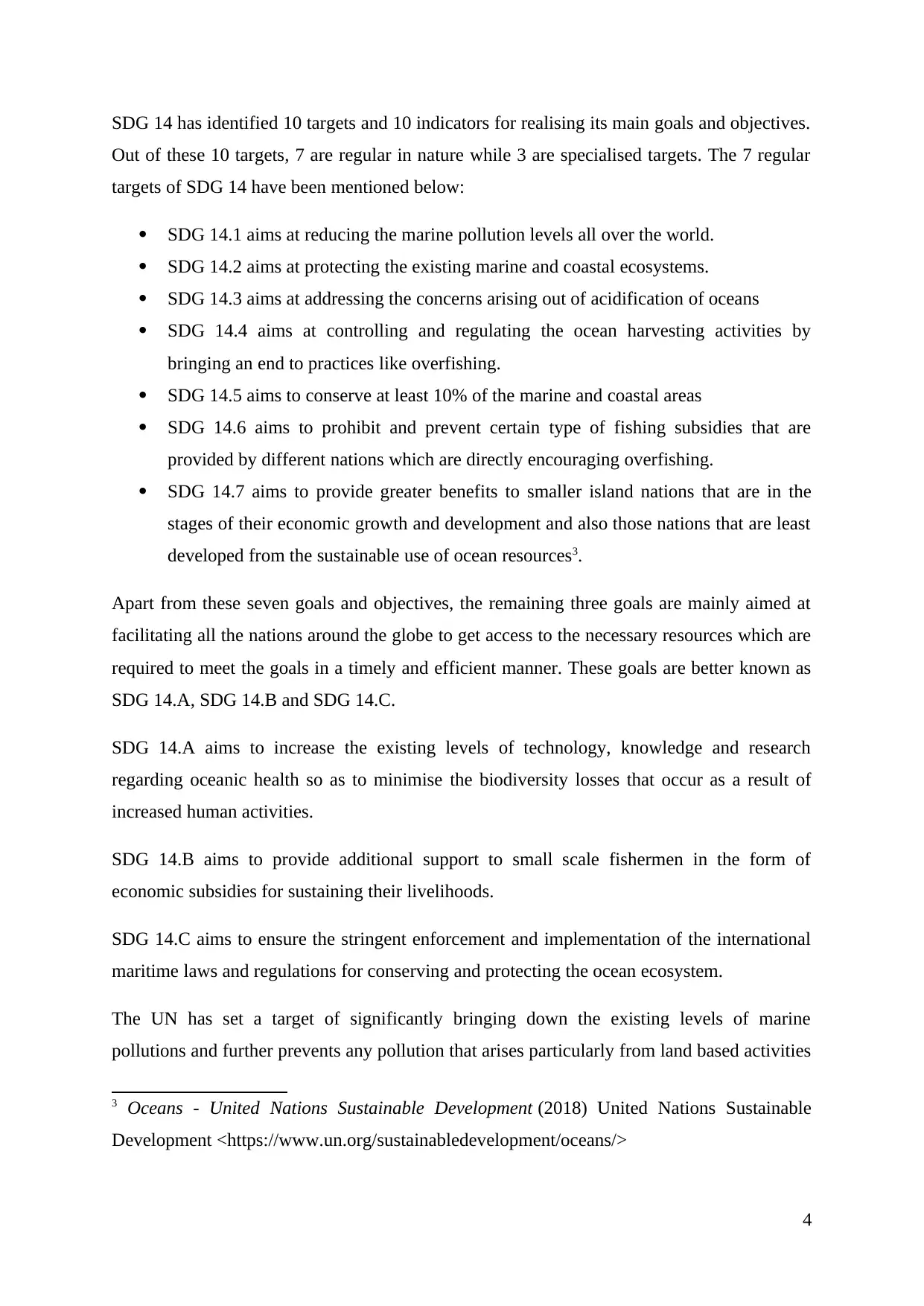
SDG 14 has identified 10 targets and 10 indicators for realising its main goals and objectives.
Out of these 10 targets, 7 are regular in nature while 3 are specialised targets. The 7 regular
targets of SDG 14 have been mentioned below:
SDG 14.1 aims at reducing the marine pollution levels all over the world.
SDG 14.2 aims at protecting the existing marine and coastal ecosystems.
SDG 14.3 aims at addressing the concerns arising out of acidification of oceans
SDG 14.4 aims at controlling and regulating the ocean harvesting activities by
bringing an end to practices like overfishing.
SDG 14.5 aims to conserve at least 10% of the marine and coastal areas
SDG 14.6 aims to prohibit and prevent certain type of fishing subsidies that are
provided by different nations which are directly encouraging overfishing.
SDG 14.7 aims to provide greater benefits to smaller island nations that are in the
stages of their economic growth and development and also those nations that are least
developed from the sustainable use of ocean resources3.
Apart from these seven goals and objectives, the remaining three goals are mainly aimed at
facilitating all the nations around the globe to get access to the necessary resources which are
required to meet the goals in a timely and efficient manner. These goals are better known as
SDG 14.A, SDG 14.B and SDG 14.C.
SDG 14.A aims to increase the existing levels of technology, knowledge and research
regarding oceanic health so as to minimise the biodiversity losses that occur as a result of
increased human activities.
SDG 14.B aims to provide additional support to small scale fishermen in the form of
economic subsidies for sustaining their livelihoods.
SDG 14.C aims to ensure the stringent enforcement and implementation of the international
maritime laws and regulations for conserving and protecting the ocean ecosystem.
The UN has set a target of significantly bringing down the existing levels of marine
pollutions and further prevents any pollution that arises particularly from land based activities
3 Oceans - United Nations Sustainable Development (2018) United Nations Sustainable
Development <https://www.un.org/sustainabledevelopment/oceans/>
4
Out of these 10 targets, 7 are regular in nature while 3 are specialised targets. The 7 regular
targets of SDG 14 have been mentioned below:
SDG 14.1 aims at reducing the marine pollution levels all over the world.
SDG 14.2 aims at protecting the existing marine and coastal ecosystems.
SDG 14.3 aims at addressing the concerns arising out of acidification of oceans
SDG 14.4 aims at controlling and regulating the ocean harvesting activities by
bringing an end to practices like overfishing.
SDG 14.5 aims to conserve at least 10% of the marine and coastal areas
SDG 14.6 aims to prohibit and prevent certain type of fishing subsidies that are
provided by different nations which are directly encouraging overfishing.
SDG 14.7 aims to provide greater benefits to smaller island nations that are in the
stages of their economic growth and development and also those nations that are least
developed from the sustainable use of ocean resources3.
Apart from these seven goals and objectives, the remaining three goals are mainly aimed at
facilitating all the nations around the globe to get access to the necessary resources which are
required to meet the goals in a timely and efficient manner. These goals are better known as
SDG 14.A, SDG 14.B and SDG 14.C.
SDG 14.A aims to increase the existing levels of technology, knowledge and research
regarding oceanic health so as to minimise the biodiversity losses that occur as a result of
increased human activities.
SDG 14.B aims to provide additional support to small scale fishermen in the form of
economic subsidies for sustaining their livelihoods.
SDG 14.C aims to ensure the stringent enforcement and implementation of the international
maritime laws and regulations for conserving and protecting the ocean ecosystem.
The UN has set a target of significantly bringing down the existing levels of marine
pollutions and further prevents any pollution that arises particularly from land based activities
3 Oceans - United Nations Sustainable Development (2018) United Nations Sustainable
Development <https://www.un.org/sustainabledevelopment/oceans/>
4
Paraphrase This Document
Need a fresh take? Get an instant paraphrase of this document with our AI Paraphraser
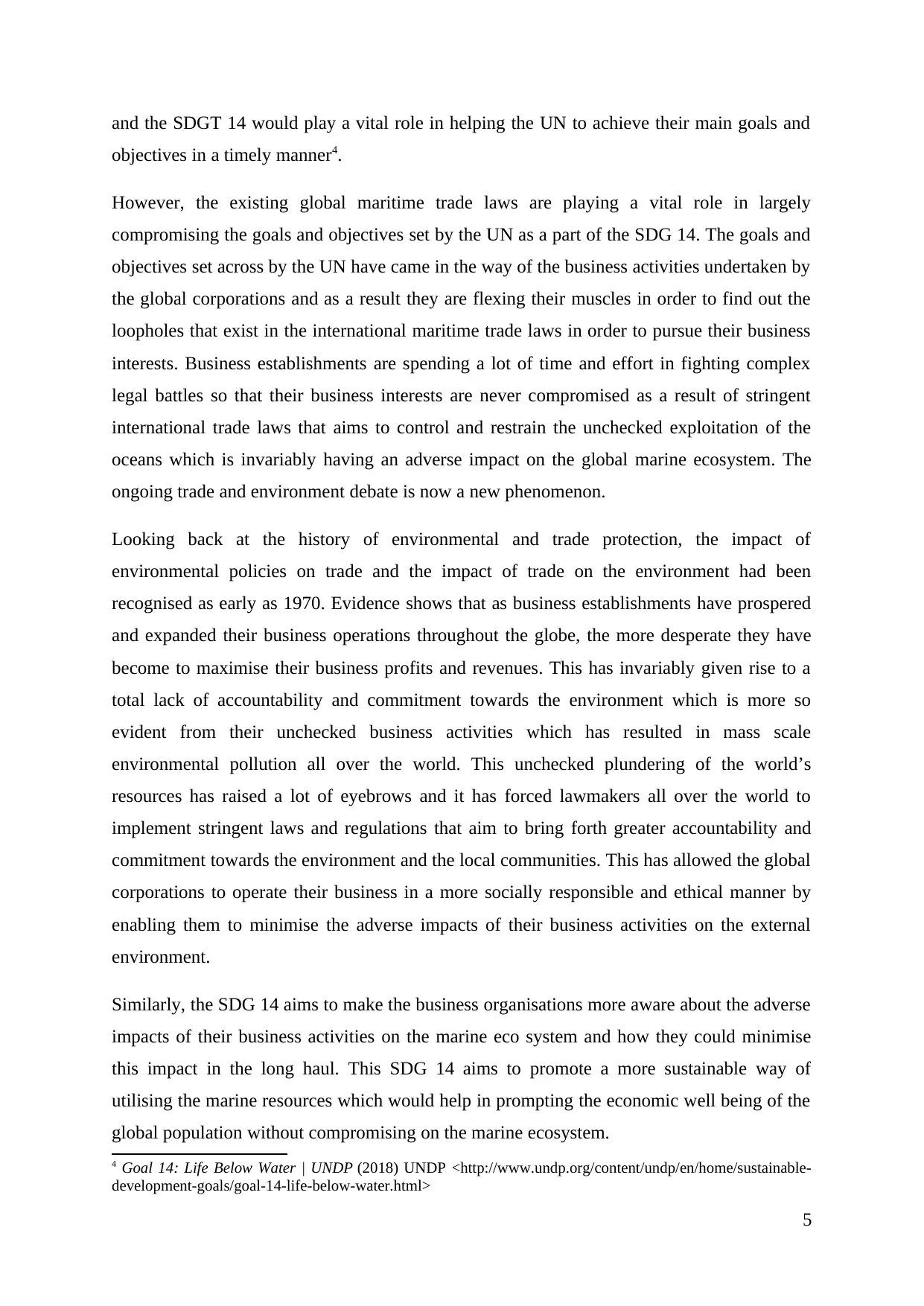
and the SDGT 14 would play a vital role in helping the UN to achieve their main goals and
objectives in a timely manner4.
However, the existing global maritime trade laws are playing a vital role in largely
compromising the goals and objectives set by the UN as a part of the SDG 14. The goals and
objectives set across by the UN have came in the way of the business activities undertaken by
the global corporations and as a result they are flexing their muscles in order to find out the
loopholes that exist in the international maritime trade laws in order to pursue their business
interests. Business establishments are spending a lot of time and effort in fighting complex
legal battles so that their business interests are never compromised as a result of stringent
international trade laws that aims to control and restrain the unchecked exploitation of the
oceans which is invariably having an adverse impact on the global marine ecosystem. The
ongoing trade and environment debate is now a new phenomenon.
Looking back at the history of environmental and trade protection, the impact of
environmental policies on trade and the impact of trade on the environment had been
recognised as early as 1970. Evidence shows that as business establishments have prospered
and expanded their business operations throughout the globe, the more desperate they have
become to maximise their business profits and revenues. This has invariably given rise to a
total lack of accountability and commitment towards the environment which is more so
evident from their unchecked business activities which has resulted in mass scale
environmental pollution all over the world. This unchecked plundering of the world’s
resources has raised a lot of eyebrows and it has forced lawmakers all over the world to
implement stringent laws and regulations that aim to bring forth greater accountability and
commitment towards the environment and the local communities. This has allowed the global
corporations to operate their business in a more socially responsible and ethical manner by
enabling them to minimise the adverse impacts of their business activities on the external
environment.
Similarly, the SDG 14 aims to make the business organisations more aware about the adverse
impacts of their business activities on the marine eco system and how they could minimise
this impact in the long haul. This SDG 14 aims to promote a more sustainable way of
utilising the marine resources which would help in prompting the economic well being of the
global population without compromising on the marine ecosystem.
4 Goal 14: Life Below Water | UNDP (2018) UNDP <http://www.undp.org/content/undp/en/home/sustainable-
development-goals/goal-14-life-below-water.html>
5
objectives in a timely manner4.
However, the existing global maritime trade laws are playing a vital role in largely
compromising the goals and objectives set by the UN as a part of the SDG 14. The goals and
objectives set across by the UN have came in the way of the business activities undertaken by
the global corporations and as a result they are flexing their muscles in order to find out the
loopholes that exist in the international maritime trade laws in order to pursue their business
interests. Business establishments are spending a lot of time and effort in fighting complex
legal battles so that their business interests are never compromised as a result of stringent
international trade laws that aims to control and restrain the unchecked exploitation of the
oceans which is invariably having an adverse impact on the global marine ecosystem. The
ongoing trade and environment debate is now a new phenomenon.
Looking back at the history of environmental and trade protection, the impact of
environmental policies on trade and the impact of trade on the environment had been
recognised as early as 1970. Evidence shows that as business establishments have prospered
and expanded their business operations throughout the globe, the more desperate they have
become to maximise their business profits and revenues. This has invariably given rise to a
total lack of accountability and commitment towards the environment which is more so
evident from their unchecked business activities which has resulted in mass scale
environmental pollution all over the world. This unchecked plundering of the world’s
resources has raised a lot of eyebrows and it has forced lawmakers all over the world to
implement stringent laws and regulations that aim to bring forth greater accountability and
commitment towards the environment and the local communities. This has allowed the global
corporations to operate their business in a more socially responsible and ethical manner by
enabling them to minimise the adverse impacts of their business activities on the external
environment.
Similarly, the SDG 14 aims to make the business organisations more aware about the adverse
impacts of their business activities on the marine eco system and how they could minimise
this impact in the long haul. This SDG 14 aims to promote a more sustainable way of
utilising the marine resources which would help in prompting the economic well being of the
global population without compromising on the marine ecosystem.
4 Goal 14: Life Below Water | UNDP (2018) UNDP <http://www.undp.org/content/undp/en/home/sustainable-
development-goals/goal-14-life-below-water.html>
5
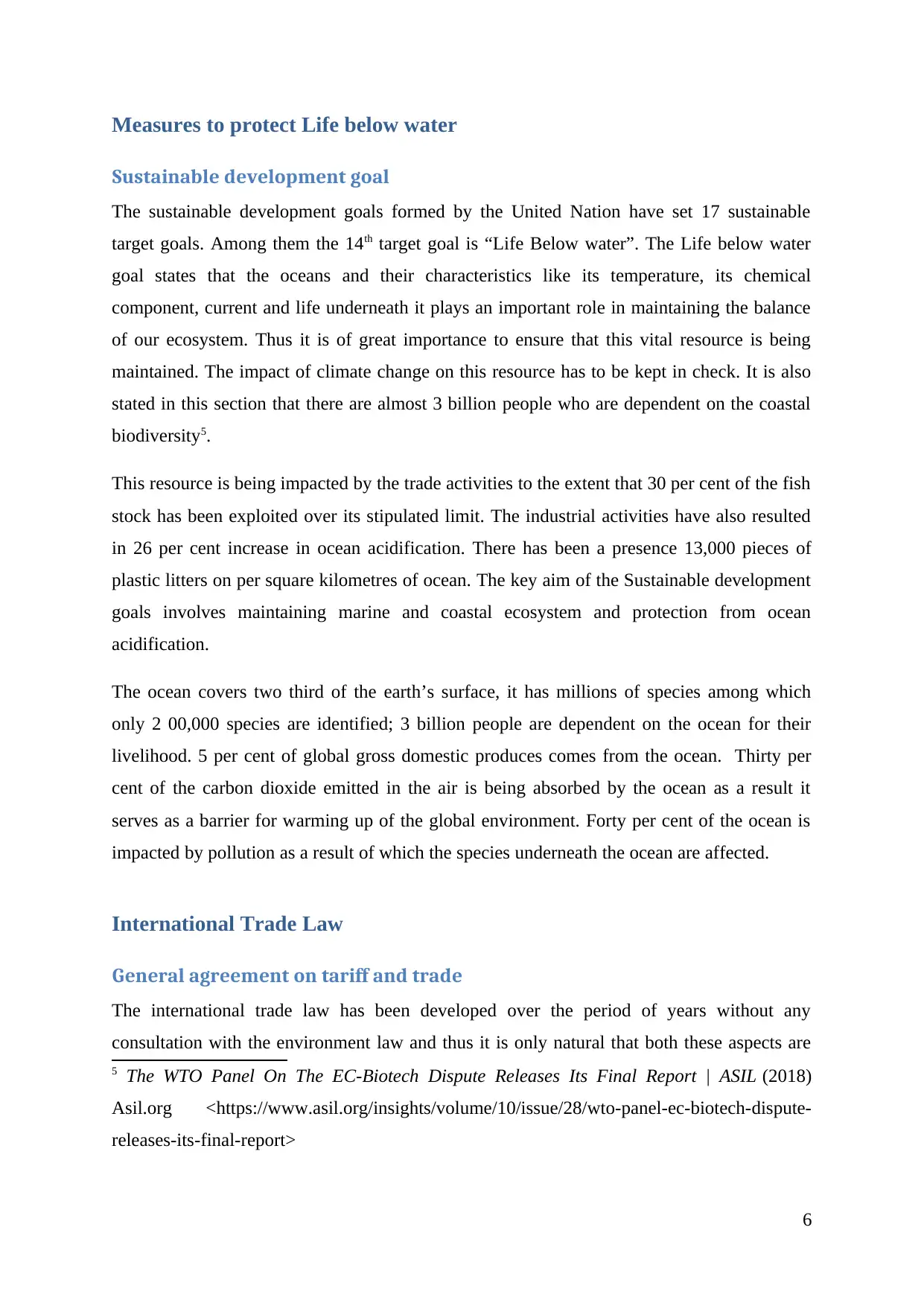
Measures to protect Life below water
Sustainable development goal
The sustainable development goals formed by the United Nation have set 17 sustainable
target goals. Among them the 14th target goal is “Life Below water”. The Life below water
goal states that the oceans and their characteristics like its temperature, its chemical
component, current and life underneath it plays an important role in maintaining the balance
of our ecosystem. Thus it is of great importance to ensure that this vital resource is being
maintained. The impact of climate change on this resource has to be kept in check. It is also
stated in this section that there are almost 3 billion people who are dependent on the coastal
biodiversity5.
This resource is being impacted by the trade activities to the extent that 30 per cent of the fish
stock has been exploited over its stipulated limit. The industrial activities have also resulted
in 26 per cent increase in ocean acidification. There has been a presence 13,000 pieces of
plastic litters on per square kilometres of ocean. The key aim of the Sustainable development
goals involves maintaining marine and coastal ecosystem and protection from ocean
acidification.
The ocean covers two third of the earth’s surface, it has millions of species among which
only 2 00,000 species are identified; 3 billion people are dependent on the ocean for their
livelihood. 5 per cent of global gross domestic produces comes from the ocean. Thirty per
cent of the carbon dioxide emitted in the air is being absorbed by the ocean as a result it
serves as a barrier for warming up of the global environment. Forty per cent of the ocean is
impacted by pollution as a result of which the species underneath the ocean are affected.
International Trade Law
General agreement on tariff and trade
The international trade law has been developed over the period of years without any
consultation with the environment law and thus it is only natural that both these aspects are
5 The WTO Panel On The EC-Biotech Dispute Releases Its Final Report | ASIL (2018)
Asil.org <https://www.asil.org/insights/volume/10/issue/28/wto-panel-ec-biotech-dispute-
releases-its-final-report>
6
Sustainable development goal
The sustainable development goals formed by the United Nation have set 17 sustainable
target goals. Among them the 14th target goal is “Life Below water”. The Life below water
goal states that the oceans and their characteristics like its temperature, its chemical
component, current and life underneath it plays an important role in maintaining the balance
of our ecosystem. Thus it is of great importance to ensure that this vital resource is being
maintained. The impact of climate change on this resource has to be kept in check. It is also
stated in this section that there are almost 3 billion people who are dependent on the coastal
biodiversity5.
This resource is being impacted by the trade activities to the extent that 30 per cent of the fish
stock has been exploited over its stipulated limit. The industrial activities have also resulted
in 26 per cent increase in ocean acidification. There has been a presence 13,000 pieces of
plastic litters on per square kilometres of ocean. The key aim of the Sustainable development
goals involves maintaining marine and coastal ecosystem and protection from ocean
acidification.
The ocean covers two third of the earth’s surface, it has millions of species among which
only 2 00,000 species are identified; 3 billion people are dependent on the ocean for their
livelihood. 5 per cent of global gross domestic produces comes from the ocean. Thirty per
cent of the carbon dioxide emitted in the air is being absorbed by the ocean as a result it
serves as a barrier for warming up of the global environment. Forty per cent of the ocean is
impacted by pollution as a result of which the species underneath the ocean are affected.
International Trade Law
General agreement on tariff and trade
The international trade law has been developed over the period of years without any
consultation with the environment law and thus it is only natural that both these aspects are
5 The WTO Panel On The EC-Biotech Dispute Releases Its Final Report | ASIL (2018)
Asil.org <https://www.asil.org/insights/volume/10/issue/28/wto-panel-ec-biotech-dispute-
releases-its-final-report>
6
⊘ This is a preview!⊘
Do you want full access?
Subscribe today to unlock all pages.

Trusted by 1+ million students worldwide
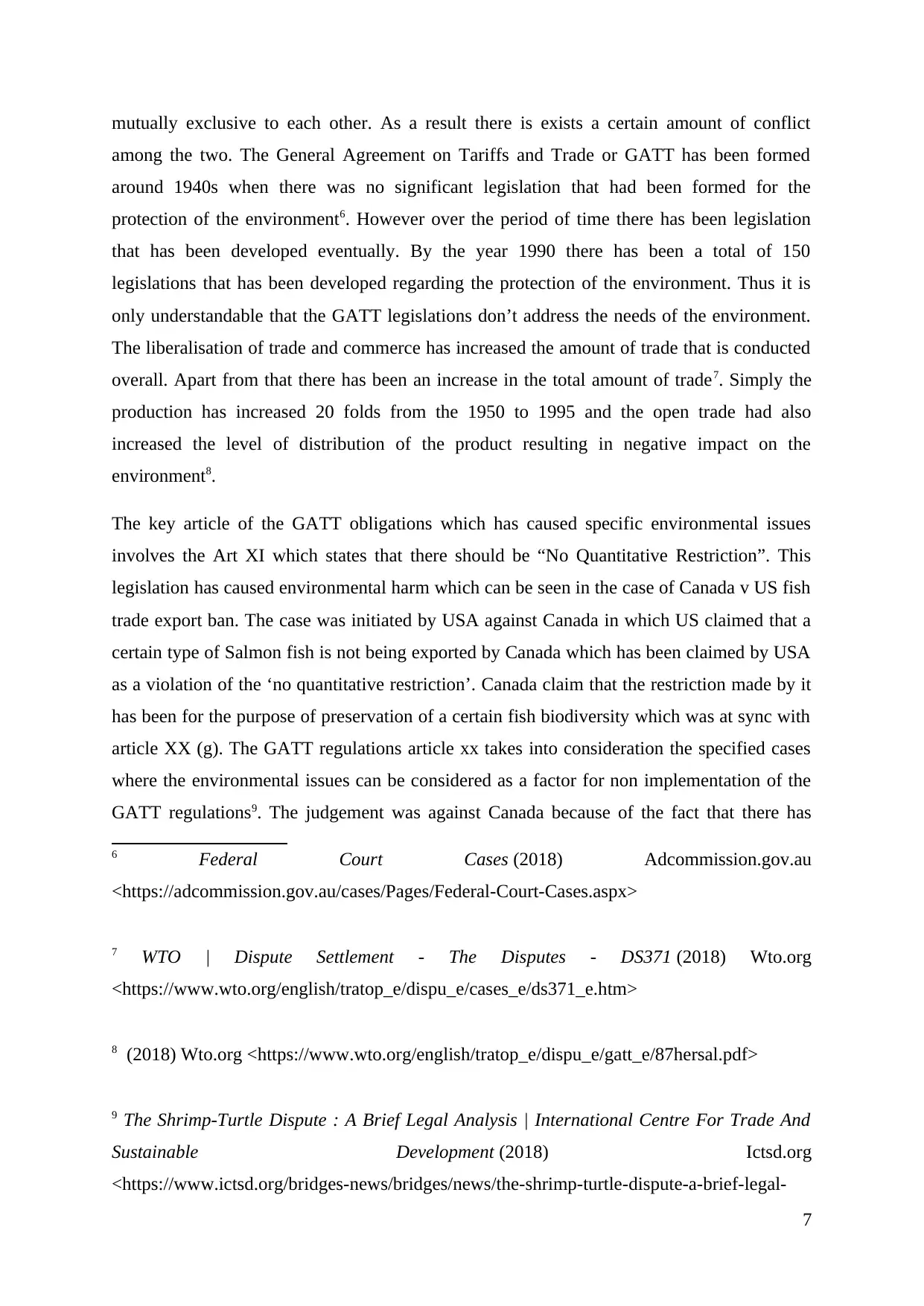
mutually exclusive to each other. As a result there is exists a certain amount of conflict
among the two. The General Agreement on Tariffs and Trade or GATT has been formed
around 1940s when there was no significant legislation that had been formed for the
protection of the environment6. However over the period of time there has been legislation
that has been developed eventually. By the year 1990 there has been a total of 150
legislations that has been developed regarding the protection of the environment. Thus it is
only understandable that the GATT legislations don’t address the needs of the environment.
The liberalisation of trade and commerce has increased the amount of trade that is conducted
overall. Apart from that there has been an increase in the total amount of trade7. Simply the
production has increased 20 folds from the 1950 to 1995 and the open trade had also
increased the level of distribution of the product resulting in negative impact on the
environment8.
The key article of the GATT obligations which has caused specific environmental issues
involves the Art XI which states that there should be “No Quantitative Restriction”. This
legislation has caused environmental harm which can be seen in the case of Canada v US fish
trade export ban. The case was initiated by USA against Canada in which US claimed that a
certain type of Salmon fish is not being exported by Canada which has been claimed by USA
as a violation of the ‘no quantitative restriction’. Canada claim that the restriction made by it
has been for the purpose of preservation of a certain fish biodiversity which was at sync with
article XX (g). The GATT regulations article xx takes into consideration the specified cases
where the environmental issues can be considered as a factor for non implementation of the
GATT regulations9. The judgement was against Canada because of the fact that there has
6 Federal Court Cases (2018) Adcommission.gov.au
<https://adcommission.gov.au/cases/Pages/Federal-Court-Cases.aspx>
7 WTO | Dispute Settlement - The Disputes - DS371 (2018) Wto.org
<https://www.wto.org/english/tratop_e/dispu_e/cases_e/ds371_e.htm>
8 (2018) Wto.org <https://www.wto.org/english/tratop_e/dispu_e/gatt_e/87hersal.pdf>
9 The Shrimp-Turtle Dispute : A Brief Legal Analysis | International Centre For Trade And
Sustainable Development (2018) Ictsd.org
<https://www.ictsd.org/bridges-news/bridges/news/the-shrimp-turtle-dispute-a-brief-legal-
7
among the two. The General Agreement on Tariffs and Trade or GATT has been formed
around 1940s when there was no significant legislation that had been formed for the
protection of the environment6. However over the period of time there has been legislation
that has been developed eventually. By the year 1990 there has been a total of 150
legislations that has been developed regarding the protection of the environment. Thus it is
only understandable that the GATT legislations don’t address the needs of the environment.
The liberalisation of trade and commerce has increased the amount of trade that is conducted
overall. Apart from that there has been an increase in the total amount of trade7. Simply the
production has increased 20 folds from the 1950 to 1995 and the open trade had also
increased the level of distribution of the product resulting in negative impact on the
environment8.
The key article of the GATT obligations which has caused specific environmental issues
involves the Art XI which states that there should be “No Quantitative Restriction”. This
legislation has caused environmental harm which can be seen in the case of Canada v US fish
trade export ban. The case was initiated by USA against Canada in which US claimed that a
certain type of Salmon fish is not being exported by Canada which has been claimed by USA
as a violation of the ‘no quantitative restriction’. Canada claim that the restriction made by it
has been for the purpose of preservation of a certain fish biodiversity which was at sync with
article XX (g). The GATT regulations article xx takes into consideration the specified cases
where the environmental issues can be considered as a factor for non implementation of the
GATT regulations9. The judgement was against Canada because of the fact that there has
6 Federal Court Cases (2018) Adcommission.gov.au
<https://adcommission.gov.au/cases/Pages/Federal-Court-Cases.aspx>
7 WTO | Dispute Settlement - The Disputes - DS371 (2018) Wto.org
<https://www.wto.org/english/tratop_e/dispu_e/cases_e/ds371_e.htm>
8 (2018) Wto.org <https://www.wto.org/english/tratop_e/dispu_e/gatt_e/87hersal.pdf>
9 The Shrimp-Turtle Dispute : A Brief Legal Analysis | International Centre For Trade And
Sustainable Development (2018) Ictsd.org
<https://www.ictsd.org/bridges-news/bridges/news/the-shrimp-turtle-dispute-a-brief-legal-
7
Paraphrase This Document
Need a fresh take? Get an instant paraphrase of this document with our AI Paraphraser
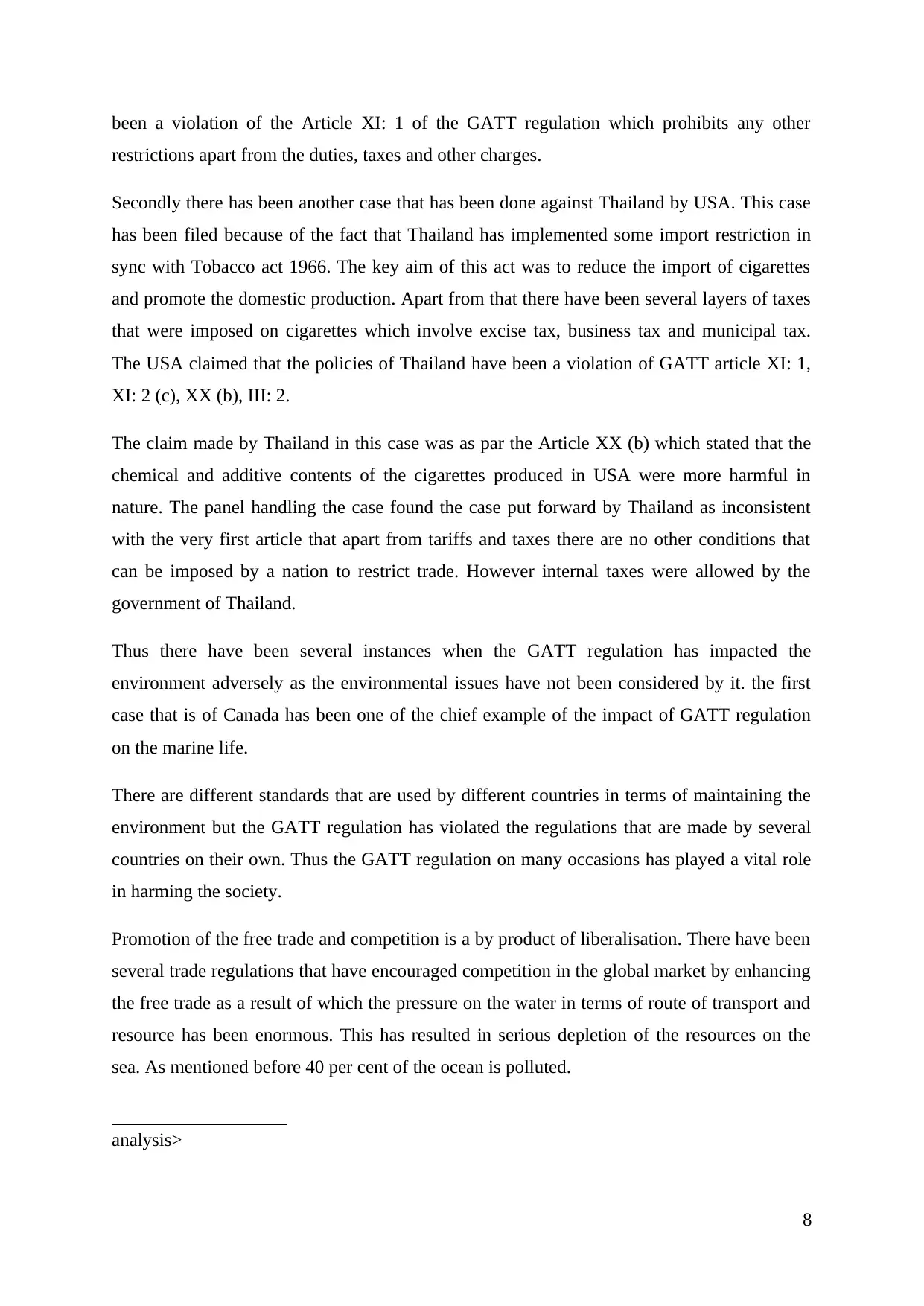
been a violation of the Article XI: 1 of the GATT regulation which prohibits any other
restrictions apart from the duties, taxes and other charges.
Secondly there has been another case that has been done against Thailand by USA. This case
has been filed because of the fact that Thailand has implemented some import restriction in
sync with Tobacco act 1966. The key aim of this act was to reduce the import of cigarettes
and promote the domestic production. Apart from that there have been several layers of taxes
that were imposed on cigarettes which involve excise tax, business tax and municipal tax.
The USA claimed that the policies of Thailand have been a violation of GATT article XI: 1,
XI: 2 (c), XX (b), III: 2.
The claim made by Thailand in this case was as par the Article XX (b) which stated that the
chemical and additive contents of the cigarettes produced in USA were more harmful in
nature. The panel handling the case found the case put forward by Thailand as inconsistent
with the very first article that apart from tariffs and taxes there are no other conditions that
can be imposed by a nation to restrict trade. However internal taxes were allowed by the
government of Thailand.
Thus there have been several instances when the GATT regulation has impacted the
environment adversely as the environmental issues have not been considered by it. the first
case that is of Canada has been one of the chief example of the impact of GATT regulation
on the marine life.
There are different standards that are used by different countries in terms of maintaining the
environment but the GATT regulation has violated the regulations that are made by several
countries on their own. Thus the GATT regulation on many occasions has played a vital role
in harming the society.
Promotion of the free trade and competition is a by product of liberalisation. There have been
several trade regulations that have encouraged competition in the global market by enhancing
the free trade as a result of which the pressure on the water in terms of route of transport and
resource has been enormous. This has resulted in serious depletion of the resources on the
sea. As mentioned before 40 per cent of the ocean is polluted.
analysis>
8
restrictions apart from the duties, taxes and other charges.
Secondly there has been another case that has been done against Thailand by USA. This case
has been filed because of the fact that Thailand has implemented some import restriction in
sync with Tobacco act 1966. The key aim of this act was to reduce the import of cigarettes
and promote the domestic production. Apart from that there have been several layers of taxes
that were imposed on cigarettes which involve excise tax, business tax and municipal tax.
The USA claimed that the policies of Thailand have been a violation of GATT article XI: 1,
XI: 2 (c), XX (b), III: 2.
The claim made by Thailand in this case was as par the Article XX (b) which stated that the
chemical and additive contents of the cigarettes produced in USA were more harmful in
nature. The panel handling the case found the case put forward by Thailand as inconsistent
with the very first article that apart from tariffs and taxes there are no other conditions that
can be imposed by a nation to restrict trade. However internal taxes were allowed by the
government of Thailand.
Thus there have been several instances when the GATT regulation has impacted the
environment adversely as the environmental issues have not been considered by it. the first
case that is of Canada has been one of the chief example of the impact of GATT regulation
on the marine life.
There are different standards that are used by different countries in terms of maintaining the
environment but the GATT regulation has violated the regulations that are made by several
countries on their own. Thus the GATT regulation on many occasions has played a vital role
in harming the society.
Promotion of the free trade and competition is a by product of liberalisation. There have been
several trade regulations that have encouraged competition in the global market by enhancing
the free trade as a result of which the pressure on the water in terms of route of transport and
resource has been enormous. This has resulted in serious depletion of the resources on the
sea. As mentioned before 40 per cent of the ocean is polluted.
analysis>
8
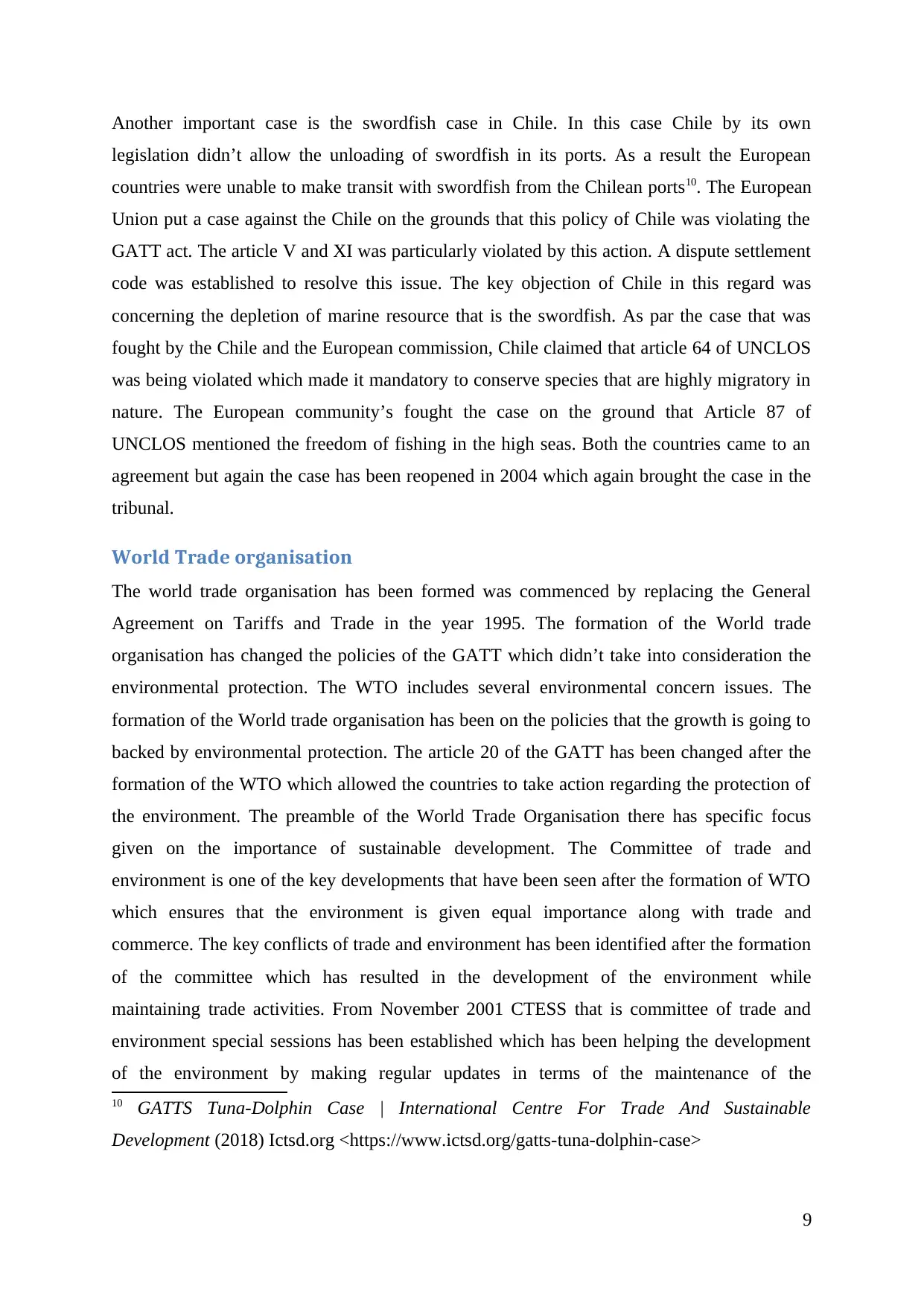
Another important case is the swordfish case in Chile. In this case Chile by its own
legislation didn’t allow the unloading of swordfish in its ports. As a result the European
countries were unable to make transit with swordfish from the Chilean ports10. The European
Union put a case against the Chile on the grounds that this policy of Chile was violating the
GATT act. The article V and XI was particularly violated by this action. A dispute settlement
code was established to resolve this issue. The key objection of Chile in this regard was
concerning the depletion of marine resource that is the swordfish. As par the case that was
fought by the Chile and the European commission, Chile claimed that article 64 of UNCLOS
was being violated which made it mandatory to conserve species that are highly migratory in
nature. The European community’s fought the case on the ground that Article 87 of
UNCLOS mentioned the freedom of fishing in the high seas. Both the countries came to an
agreement but again the case has been reopened in 2004 which again brought the case in the
tribunal.
World Trade organisation
The world trade organisation has been formed was commenced by replacing the General
Agreement on Tariffs and Trade in the year 1995. The formation of the World trade
organisation has changed the policies of the GATT which didn’t take into consideration the
environmental protection. The WTO includes several environmental concern issues. The
formation of the World trade organisation has been on the policies that the growth is going to
backed by environmental protection. The article 20 of the GATT has been changed after the
formation of the WTO which allowed the countries to take action regarding the protection of
the environment. The preamble of the World Trade Organisation there has specific focus
given on the importance of sustainable development. The Committee of trade and
environment is one of the key developments that have been seen after the formation of WTO
which ensures that the environment is given equal importance along with trade and
commerce. The key conflicts of trade and environment has been identified after the formation
of the committee which has resulted in the development of the environment while
maintaining trade activities. From November 2001 CTESS that is committee of trade and
environment special sessions has been established which has been helping the development
of the environment by making regular updates in terms of the maintenance of the
10 GATTS Tuna-Dolphin Case | International Centre For Trade And Sustainable
Development (2018) Ictsd.org <https://www.ictsd.org/gatts-tuna-dolphin-case>
9
legislation didn’t allow the unloading of swordfish in its ports. As a result the European
countries were unable to make transit with swordfish from the Chilean ports10. The European
Union put a case against the Chile on the grounds that this policy of Chile was violating the
GATT act. The article V and XI was particularly violated by this action. A dispute settlement
code was established to resolve this issue. The key objection of Chile in this regard was
concerning the depletion of marine resource that is the swordfish. As par the case that was
fought by the Chile and the European commission, Chile claimed that article 64 of UNCLOS
was being violated which made it mandatory to conserve species that are highly migratory in
nature. The European community’s fought the case on the ground that Article 87 of
UNCLOS mentioned the freedom of fishing in the high seas. Both the countries came to an
agreement but again the case has been reopened in 2004 which again brought the case in the
tribunal.
World Trade organisation
The world trade organisation has been formed was commenced by replacing the General
Agreement on Tariffs and Trade in the year 1995. The formation of the World trade
organisation has changed the policies of the GATT which didn’t take into consideration the
environmental protection. The WTO includes several environmental concern issues. The
formation of the World trade organisation has been on the policies that the growth is going to
backed by environmental protection. The article 20 of the GATT has been changed after the
formation of the WTO which allowed the countries to take action regarding the protection of
the environment. The preamble of the World Trade Organisation there has specific focus
given on the importance of sustainable development. The Committee of trade and
environment is one of the key developments that have been seen after the formation of WTO
which ensures that the environment is given equal importance along with trade and
commerce. The key conflicts of trade and environment has been identified after the formation
of the committee which has resulted in the development of the environment while
maintaining trade activities. From November 2001 CTESS that is committee of trade and
environment special sessions has been established which has been helping the development
of the environment by making regular updates in terms of the maintenance of the
10 GATTS Tuna-Dolphin Case | International Centre For Trade And Sustainable
Development (2018) Ictsd.org <https://www.ictsd.org/gatts-tuna-dolphin-case>
9
⊘ This is a preview!⊘
Do you want full access?
Subscribe today to unlock all pages.

Trusted by 1+ million students worldwide
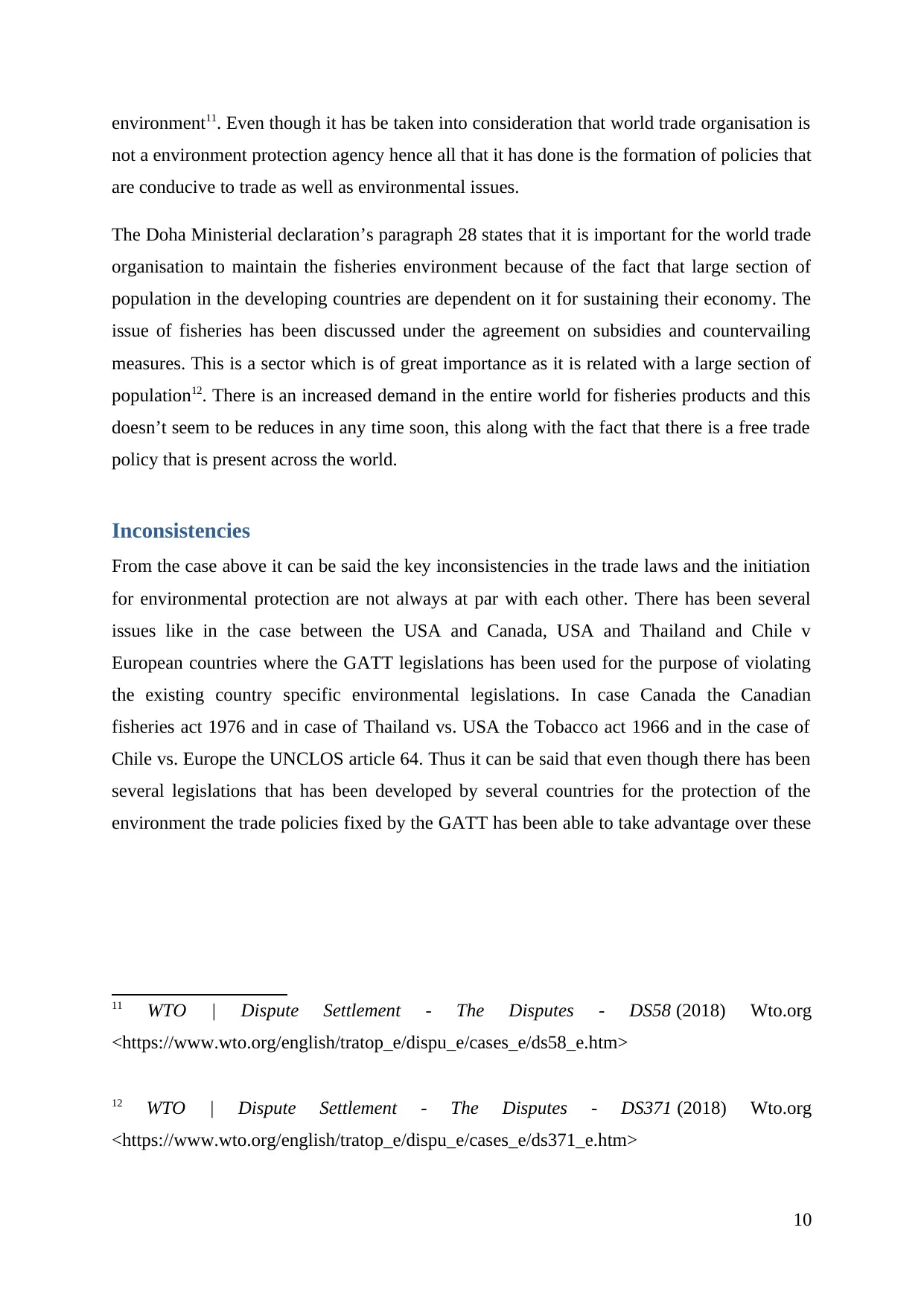
environment11. Even though it has be taken into consideration that world trade organisation is
not a environment protection agency hence all that it has done is the formation of policies that
are conducive to trade as well as environmental issues.
The Doha Ministerial declaration’s paragraph 28 states that it is important for the world trade
organisation to maintain the fisheries environment because of the fact that large section of
population in the developing countries are dependent on it for sustaining their economy. The
issue of fisheries has been discussed under the agreement on subsidies and countervailing
measures. This is a sector which is of great importance as it is related with a large section of
population12. There is an increased demand in the entire world for fisheries products and this
doesn’t seem to be reduces in any time soon, this along with the fact that there is a free trade
policy that is present across the world.
Inconsistencies
From the case above it can be said the key inconsistencies in the trade laws and the initiation
for environmental protection are not always at par with each other. There has been several
issues like in the case between the USA and Canada, USA and Thailand and Chile v
European countries where the GATT legislations has been used for the purpose of violating
the existing country specific environmental legislations. In case Canada the Canadian
fisheries act 1976 and in case of Thailand vs. USA the Tobacco act 1966 and in the case of
Chile vs. Europe the UNCLOS article 64. Thus it can be said that even though there has been
several legislations that has been developed by several countries for the protection of the
environment the trade policies fixed by the GATT has been able to take advantage over these
11 WTO | Dispute Settlement - The Disputes - DS58 (2018) Wto.org
<https://www.wto.org/english/tratop_e/dispu_e/cases_e/ds58_e.htm>
12 WTO | Dispute Settlement - The Disputes - DS371 (2018) Wto.org
<https://www.wto.org/english/tratop_e/dispu_e/cases_e/ds371_e.htm>
10
not a environment protection agency hence all that it has done is the formation of policies that
are conducive to trade as well as environmental issues.
The Doha Ministerial declaration’s paragraph 28 states that it is important for the world trade
organisation to maintain the fisheries environment because of the fact that large section of
population in the developing countries are dependent on it for sustaining their economy. The
issue of fisheries has been discussed under the agreement on subsidies and countervailing
measures. This is a sector which is of great importance as it is related with a large section of
population12. There is an increased demand in the entire world for fisheries products and this
doesn’t seem to be reduces in any time soon, this along with the fact that there is a free trade
policy that is present across the world.
Inconsistencies
From the case above it can be said the key inconsistencies in the trade laws and the initiation
for environmental protection are not always at par with each other. There has been several
issues like in the case between the USA and Canada, USA and Thailand and Chile v
European countries where the GATT legislations has been used for the purpose of violating
the existing country specific environmental legislations. In case Canada the Canadian
fisheries act 1976 and in case of Thailand vs. USA the Tobacco act 1966 and in the case of
Chile vs. Europe the UNCLOS article 64. Thus it can be said that even though there has been
several legislations that has been developed by several countries for the protection of the
environment the trade policies fixed by the GATT has been able to take advantage over these
11 WTO | Dispute Settlement - The Disputes - DS58 (2018) Wto.org
<https://www.wto.org/english/tratop_e/dispu_e/cases_e/ds58_e.htm>
12 WTO | Dispute Settlement - The Disputes - DS371 (2018) Wto.org
<https://www.wto.org/english/tratop_e/dispu_e/cases_e/ds371_e.htm>
10
Paraphrase This Document
Need a fresh take? Get an instant paraphrase of this document with our AI Paraphraser
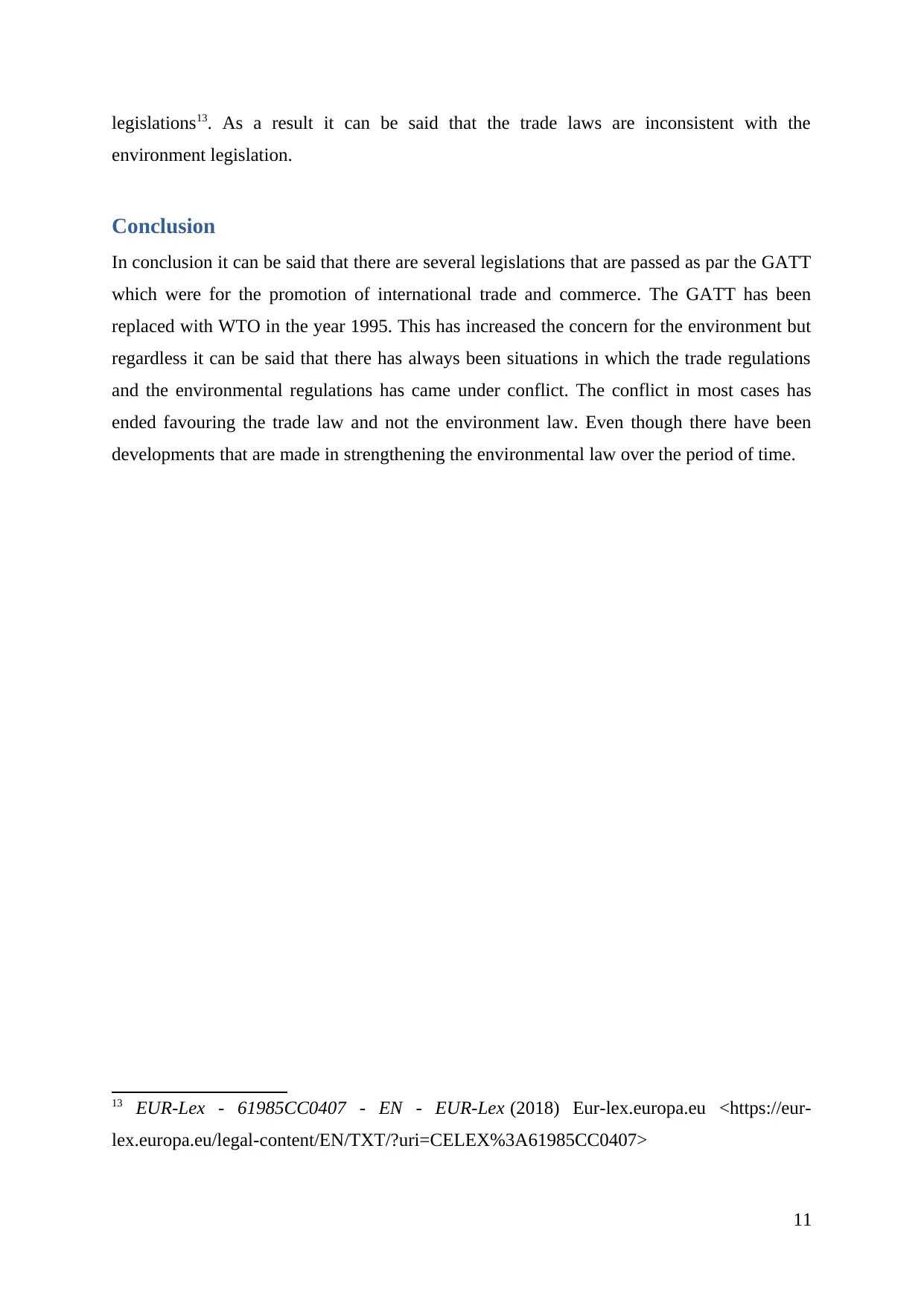
legislations13. As a result it can be said that the trade laws are inconsistent with the
environment legislation.
Conclusion
In conclusion it can be said that there are several legislations that are passed as par the GATT
which were for the promotion of international trade and commerce. The GATT has been
replaced with WTO in the year 1995. This has increased the concern for the environment but
regardless it can be said that there has always been situations in which the trade regulations
and the environmental regulations has came under conflict. The conflict in most cases has
ended favouring the trade law and not the environment law. Even though there have been
developments that are made in strengthening the environmental law over the period of time.
13 EUR-Lex - 61985CC0407 - EN - EUR-Lex (2018) Eur-lex.europa.eu <https://eur-
lex.europa.eu/legal-content/EN/TXT/?uri=CELEX%3A61985CC0407>
11
environment legislation.
Conclusion
In conclusion it can be said that there are several legislations that are passed as par the GATT
which were for the promotion of international trade and commerce. The GATT has been
replaced with WTO in the year 1995. This has increased the concern for the environment but
regardless it can be said that there has always been situations in which the trade regulations
and the environmental regulations has came under conflict. The conflict in most cases has
ended favouring the trade law and not the environment law. Even though there have been
developments that are made in strengthening the environmental law over the period of time.
13 EUR-Lex - 61985CC0407 - EN - EUR-Lex (2018) Eur-lex.europa.eu <https://eur-
lex.europa.eu/legal-content/EN/TXT/?uri=CELEX%3A61985CC0407>
11
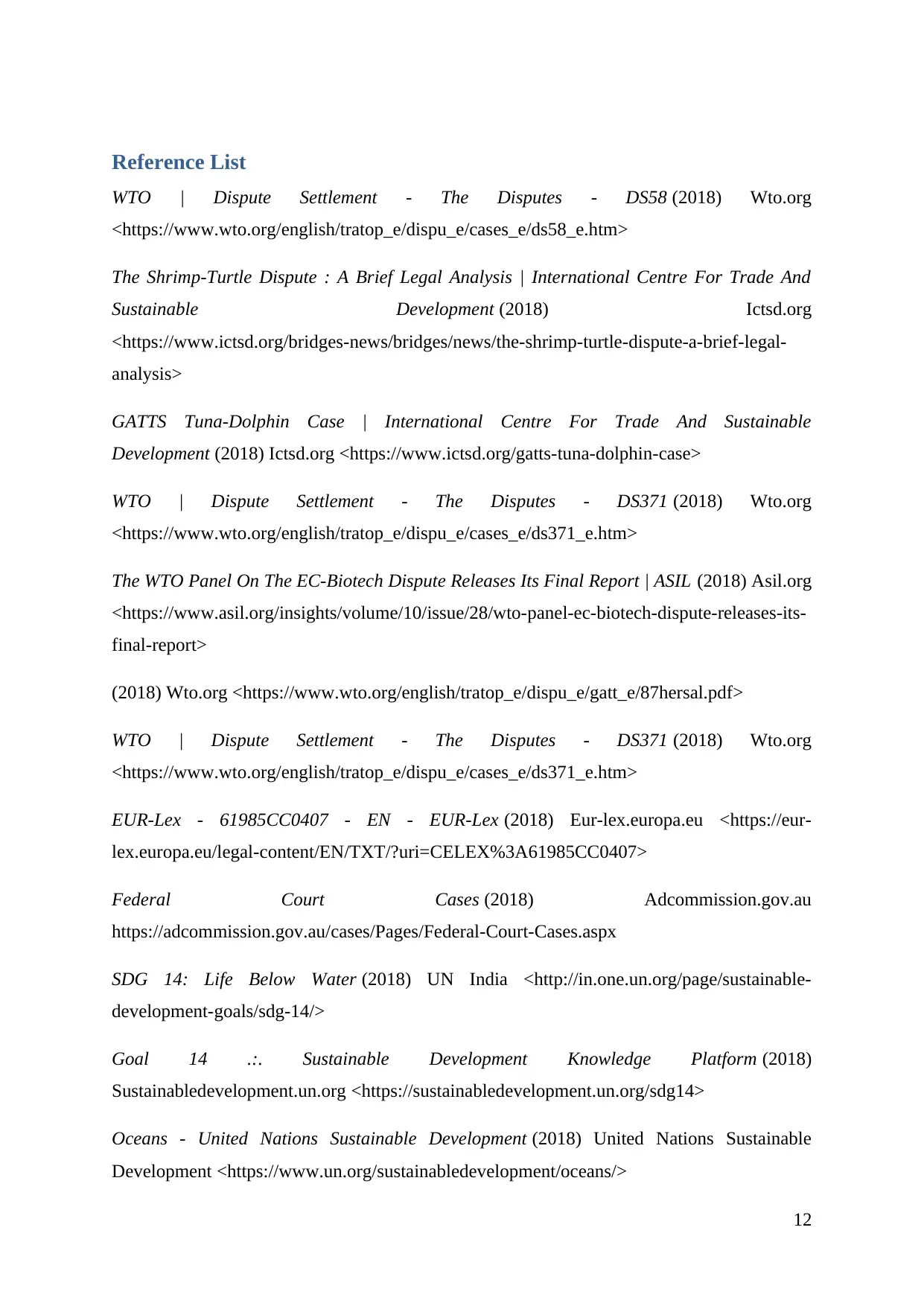
Reference List
WTO | Dispute Settlement - The Disputes - DS58 (2018) Wto.org
<https://www.wto.org/english/tratop_e/dispu_e/cases_e/ds58_e.htm>
The Shrimp-Turtle Dispute : A Brief Legal Analysis | International Centre For Trade And
Sustainable Development (2018) Ictsd.org
<https://www.ictsd.org/bridges-news/bridges/news/the-shrimp-turtle-dispute-a-brief-legal-
analysis>
GATTS Tuna-Dolphin Case | International Centre For Trade And Sustainable
Development (2018) Ictsd.org <https://www.ictsd.org/gatts-tuna-dolphin-case>
WTO | Dispute Settlement - The Disputes - DS371 (2018) Wto.org
<https://www.wto.org/english/tratop_e/dispu_e/cases_e/ds371_e.htm>
The WTO Panel On The EC-Biotech Dispute Releases Its Final Report | ASIL (2018) Asil.org
<https://www.asil.org/insights/volume/10/issue/28/wto-panel-ec-biotech-dispute-releases-its-
final-report>
(2018) Wto.org <https://www.wto.org/english/tratop_e/dispu_e/gatt_e/87hersal.pdf>
WTO | Dispute Settlement - The Disputes - DS371 (2018) Wto.org
<https://www.wto.org/english/tratop_e/dispu_e/cases_e/ds371_e.htm>
EUR-Lex - 61985CC0407 - EN - EUR-Lex (2018) Eur-lex.europa.eu <https://eur-
lex.europa.eu/legal-content/EN/TXT/?uri=CELEX%3A61985CC0407>
Federal Court Cases (2018) Adcommission.gov.au
https://adcommission.gov.au/cases/Pages/Federal-Court-Cases.aspx
SDG 14: Life Below Water (2018) UN India <http://in.one.un.org/page/sustainable-
development-goals/sdg-14/>
Goal 14 .:. Sustainable Development Knowledge Platform (2018)
Sustainabledevelopment.un.org <https://sustainabledevelopment.un.org/sdg14>
Oceans - United Nations Sustainable Development (2018) United Nations Sustainable
Development <https://www.un.org/sustainabledevelopment/oceans/>
12
WTO | Dispute Settlement - The Disputes - DS58 (2018) Wto.org
<https://www.wto.org/english/tratop_e/dispu_e/cases_e/ds58_e.htm>
The Shrimp-Turtle Dispute : A Brief Legal Analysis | International Centre For Trade And
Sustainable Development (2018) Ictsd.org
<https://www.ictsd.org/bridges-news/bridges/news/the-shrimp-turtle-dispute-a-brief-legal-
analysis>
GATTS Tuna-Dolphin Case | International Centre For Trade And Sustainable
Development (2018) Ictsd.org <https://www.ictsd.org/gatts-tuna-dolphin-case>
WTO | Dispute Settlement - The Disputes - DS371 (2018) Wto.org
<https://www.wto.org/english/tratop_e/dispu_e/cases_e/ds371_e.htm>
The WTO Panel On The EC-Biotech Dispute Releases Its Final Report | ASIL (2018) Asil.org
<https://www.asil.org/insights/volume/10/issue/28/wto-panel-ec-biotech-dispute-releases-its-
final-report>
(2018) Wto.org <https://www.wto.org/english/tratop_e/dispu_e/gatt_e/87hersal.pdf>
WTO | Dispute Settlement - The Disputes - DS371 (2018) Wto.org
<https://www.wto.org/english/tratop_e/dispu_e/cases_e/ds371_e.htm>
EUR-Lex - 61985CC0407 - EN - EUR-Lex (2018) Eur-lex.europa.eu <https://eur-
lex.europa.eu/legal-content/EN/TXT/?uri=CELEX%3A61985CC0407>
Federal Court Cases (2018) Adcommission.gov.au
https://adcommission.gov.au/cases/Pages/Federal-Court-Cases.aspx
SDG 14: Life Below Water (2018) UN India <http://in.one.un.org/page/sustainable-
development-goals/sdg-14/>
Goal 14 .:. Sustainable Development Knowledge Platform (2018)
Sustainabledevelopment.un.org <https://sustainabledevelopment.un.org/sdg14>
Oceans - United Nations Sustainable Development (2018) United Nations Sustainable
Development <https://www.un.org/sustainabledevelopment/oceans/>
12
⊘ This is a preview!⊘
Do you want full access?
Subscribe today to unlock all pages.

Trusted by 1+ million students worldwide
1 out of 13
Related Documents
Your All-in-One AI-Powered Toolkit for Academic Success.
+13062052269
info@desklib.com
Available 24*7 on WhatsApp / Email
![[object Object]](/_next/static/media/star-bottom.7253800d.svg)
Unlock your academic potential
Copyright © 2020–2025 A2Z Services. All Rights Reserved. Developed and managed by ZUCOL.





